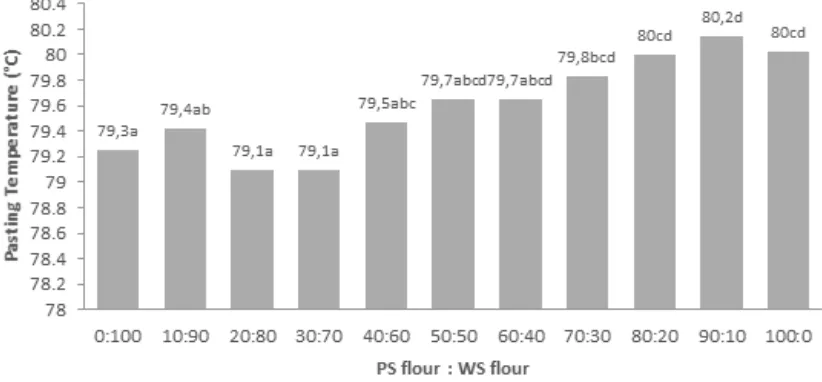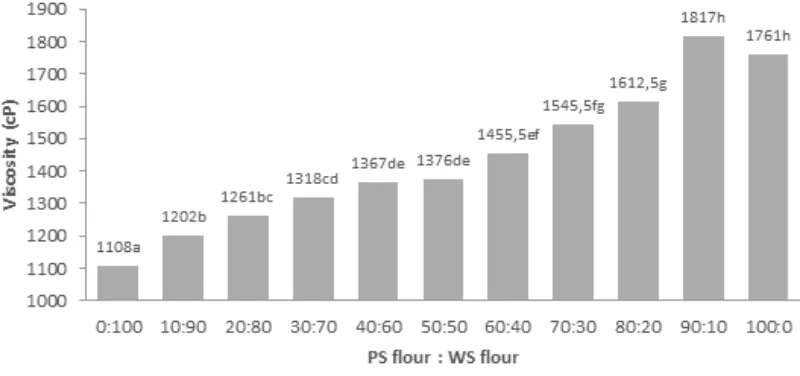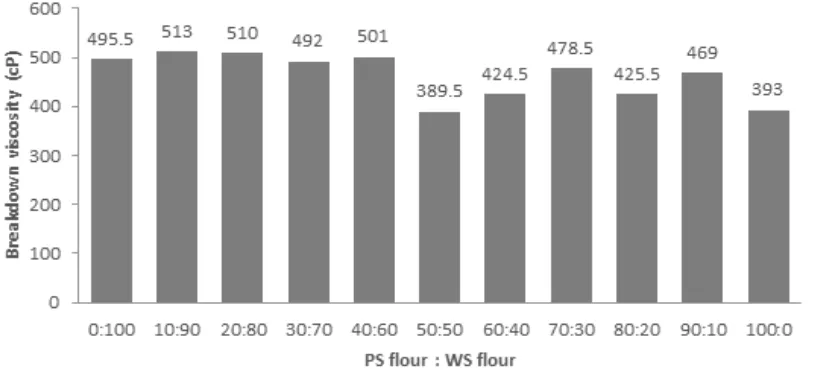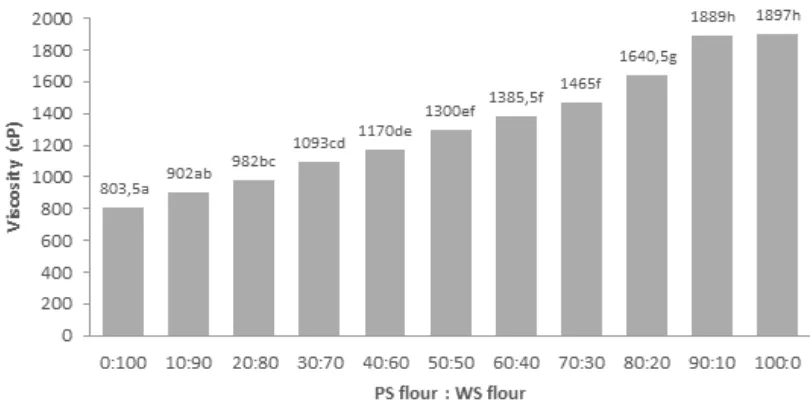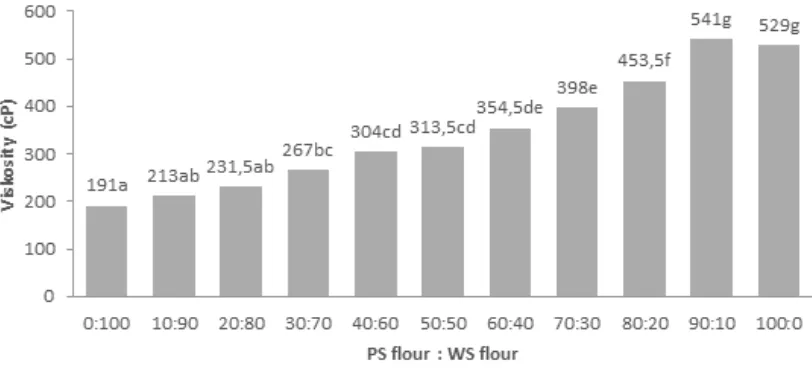PASTING CHARACTERISTICS OF COMPOSITE PURPLE SWEET POTATO
Understanding the pasting characteristics of purple sweet potato (PS) and white sweet potato (WS) flours can provide clues about the product development direction. The purpose of the study was to evaluate the pasting characteristics of composite PS and WS flours. The research was conducted by making PS and WS flours. The flours are then mixed with variation ratios of 0:100, 10:90, 20:80, 30:70, 40:60, 50:50, 60:40, 70:30, 80:20, 90:10, and 100:0. All of the composite flours then tested the pasting characteristics. The data were tested using one-way anova and Duncan at a level of 0.05. The results indicated that there was the influence of composite ratios of WS flour and PS flour to pasting temperature, peak viscosity, hold viscosity, cold viscosity and reverse viscosity. However, there was no effect on the breakdown viscosity.
Keywords: pasting, purple sweet potato, white sweet potato
INTRODUCTION
The uneven growth rate of Indonesian population with increasing food production has prompted an increase in the number of food imports. Wheat flour is one import commodity that continues to increase every year. In 2012, 2013, and 2015 Indonesia’s wheat imports are 6.250.489 tons, 6.720.509 tons, and 7.411.764 tons, respectively (Welirang, 2016). This condition is certainly not expected because it can weaken national food security.
One strategy that is often done to inhibit the high import of wheat as raw material for flour processing is with the utilization of local food. Local food is first processed into flour as a more flexible intermediate product utilization to be processed again into various food products with various forms and flavors. In addition, flour has a longer shelf life and is easy in the distribution process. One of the potential local food developed into flour is sweet potato.
Sweet potato, as a food source of carbohydrates, is composed of various components that can provide health benefits. Dutta (2015) reported that sweet potatoes have a low glycemic index, which is good for both diabetics and pre-diabetics as it regulates blood sugar and insulin metabolism. Various varieties of sweet potatoes, whether white, yellow, orange, and purple, have active components that are beneficial to health, although each has its own distinctive properties. Yellow sweet potato is composed of beta-carotene (Rose and Vasanthakaalam, 2011). Aywa et al. (2013) reported that beta-carotene is present in yellow and orange sweet potatoes, but not in WS. Odake et al. (1992), Goda et al. (1997) and Montilla et al. (2011) stated that PS is composed of anthocyanins, which give the purple color.
selling price of sweet potatoes. By considering the cheaper price, the WS has a good economic potential to be developed as the raw material of processed food products. Nevertheless, efforts are needed to improve consumer preferences of the processed products.
One effort that can be done is with composite WS flour and PS flour. The composite flour can provide a good color effect on the processed products because the intensity of the color purple on sweet potatoes is high enough. In addition, the composite flour may have an effect on the changes in the constituent component and the properties of the flour.
All varieties of sweet potatoes show different levels of starch. The specialty of sweet potatoes is its much higher amylopectin content than amylose. Senanayake et al. (2013) reported that the amylopectin content of sweet potatoes ranged from 80-85%, whereas amylose was 15-20%. Rauf (2015) explains that amylopectin has a lower water absorption, but provides better pasta stability than amylose. This can affect the quality of its processed products.
Composite of two types of flour with different properties can provide typical characteristics and does not always follow the tendency of the mixed ratio (Rauf and Sarbini, 2015). This suggests that the composite of the various ratios of WP flour and WS flour will give different characteristics of the pasta. The many variations of paste characteristics obtained can provide the development potential of various processed food products.
Various studies to improve the utilization of sweet potato and to reduce dependence on wheat flour have been done by substituting sweet potato flour. However, such substitution efforts have not been able to produce products with physical and sensory properties as well as wheat flour. This is due to the lack of utilization of information about the characteristics of sweet potato flour associated with the processing, especially those involving high temperatures.
Various characteristics of starch and flour, both physically and chemically, affect the quality of processed food products (Rauf and Sarbini, 2015). The description of the starch characteristics in the processing involving the heating process can be identified through the pasting characteristics or amylograph. The properties of the pasta can give an idea of the properties of gelatinization, heat viscosity, cold viscosity, and the stability of the pasta to heat (Rauf, 2015).
The pasting characteristics are influenced by the characteristics of flour or starch, both physically and chemically. The properties of starch and flour may provide an idea of the interaction between the pasting components during heat-processing. Understanding the pasting characteristics can be an indication of the direction of food product development research, tailored to the potential characteristics of starch or starch sources. The purpose of this study was to evaluate the pasting characteristics of composite PS flour and WS flour.
MATERIALS AND METHODS
Materials
PS and WS were the agricultural product from Boyolali Regency obtained from a traditional market in Sukoharjo.
Manufacture of Sweet Potato Flour
Pasting Characteristics Analysis
The characteristics of the paste were analyzed using a DV-II + Pro viscometer, in accordance with procedure reported by Julianti et al. (2011). A total of 1 gram of sample was inserted into viscometer chamber. Added water 10 ml then stirred. After the viscometer was turned on and the autozero process was complete, the spindle was installed immediately (SC4-28). Then set spindle spin speed at 100 RPM. Temperature control was using TC-112P. The temperature was increased gradually to 95° C. The temperature of 95° C was maintained for 10 minutes. Then gradually the temperature was lowered to 50° C.
Design and Statistical Analysis
The experimental design used was a complete randomized design. Variations of composite ratios PS and WS flours were 100:0, 90:10, 80:20, 70:30, 60:40, 50:50, 40:60, 30:70, 20:80, 10:90, and 0:100.
Data were analyzed using one way and two-way ANOVA. The difference of results will be analyzed using Duncan test at 5% level.
RESULTS & DISCUSSION
Pasting Temperature
The result of the composite PS and WS flours shows an influence on pasting temperature (p = 0,007). The higher the portion of PS flour, the higher the pasting temperature of the composite flours. The pasting temperature of the composite flours is shown in Figure 1.
Fig. 1 The pasting temperature of composite of PS and WS flours at various ratios
Peak Viscosity
Statistically, the results indicated that the composite PS and WS flours gave an effect on peak viscosity (p= 0,000). The higher the portion of PS flour, the higher the peak viscosity of the composite flour. The peak viscosity of the composite flours can be seen in Figure 2.
Fig. 2 Peak viskosity of composite of PS and WS flours at various ratios
In general, the composite flours with a higher portion of PS showed a higher peak viscosity than the mixture with a larger portion of WS flour (Figure 2). Mandasari et al. (2015) explain that peak viscosity is the maximum point of flour viscosity during the heating process. Based on the research results can be seen that the PS flour tends to have high peak viscosity. This shows that PS flour is more resistant to the heating process with high temperature than WS flour. According to Zhang et al. (2005), resistance to heat is affected by the crosslinking of starch. In addition, peak viscosity also provides an idea of the water absorption and swelling power of starch. Rauf (2015) says that the higher the peak viscosity of a starch, the higher the water absorption and the swelling power of the starch (Rauf, 2015). The ability of flour to absorb water and to swell shown by the peak viscosity indicates the quality of flour in the manufacture of food products.
Hold Viscosity
Fig. 3 Hold viscosity of composite PS and WS flours at various ratios
The result shows that PS flour has a higher hold viscosity than WS flour (Figure 3). This gives a tendency that the higher portion of PS flour, the higher the hold viscosity hold of the composite flour. Hold viscosity or trough viscosity is a measure of viscosity when the temperature of peak viscosity is maintained (Hold= 95 C) for a while, then viscosity decreases (Rauf, 2015). Adejumo et al. (2011) explain that after reaching the peak viscosity will be followed by the syneresis. Syneresis is the process of seeping water from the pasta. The hold viscosity hold of all the composite flours samples is lower than their peak viscosity. The purpose of the measurement of hold viscosity is to know the level of flour stability to the heating process and frictional force (Susanti and Harijono, 2014). The PS flour has a higher hold viscosity so that the PS is more directed to the development of food products involving high temperatures.
Breakdown Viscosity
Statistically, the result of the research on the variation of PS flour and WS flour showed that there was no effect on the breakdown viscosity (p= 0,107). The breakdown viscosity of the composite flours can be seen in Figure 4.
The breakdown viscosity is the difference between the peak viscosity and the hold viscosity (Rauf, 2015). The result displayed that various ratios of composite PS and WS did not affect the breakdown viscosity. Figure 4 shows that the breakdown viscosity range of PS flour and WS flour at various ratios is in the range of 389.5 cP to 513 cP. According to Beta and Corke (2001), the breakdown viscosity indicates the stability of flour to the heating process. The lower the breakdown viscosity, the more stable the flour in hot conditions. Adebowale et al. (2005) also explained that the magnitude of the breakdown viscosity value indicates that flour granules that have been swollen tend to be brittle and not resistant to heating and friction during the cooking process.
Cold Viscosity
The results indicated that there was the influence of variation of the composite ratio of PS flour and WS flour to cold viscosity (p= 0.000). The higher the portion of PS flour, the higher the cold viscosity of the composite flour. The cold viscosity of the composite flours can be seen in Figure 5.
Fig. 5 Cold viscosity of composite PS flour and WS flour at various ratios
The data in Fig. 5 shows that the higher portion of PS, the higher the cold viscosity of composite flour. When the temperature is lowered, then maintained at 50° C, a flour sample of flour with a larger portion of PS flour gives a higher cold viscosity compared to composite flour with a larger portion of WS flour. Composite flour with a higher portion of PS flour shows a higher cold viscosity than its peak viscosity. According to Adejumo et al. (2011) the increase in viscosity when the pasta is cooled, caused by an increase in the formation of intermolecular hydrogen bonds that lead to gel formation. While the sample with a larger portion of WS flour showed a lower cold viscosity than the peak viscosity.
Setback Viscosity
Fig. 6 Setback viscosity of composite PS flour and WS flour at various ratios
The results showed that the PS flour had higher levels of setback viscosity than WS flour
(Figure 6). This gives a tendency that the higher portion of PS, the higher the setback viscosity
of the composite flours. The degree of flour retrogradation can affect the quality of food
products produced.
Setback viscosity is the value of the difference between cold viscosity and
hold viscosity. Setback viscosity is a parameter of starch stability and an indicator of the level
of starch retrogradation during cooling (Cornell, 2000). Retrogradation is the recrystallization
or the reunification of a gelatinized starch granule (Rauf, 2015). According to Ikegwu
et al.
(2010), the higher the setback viscosity of the composite flour, the higher the level of starch
retrogradation during cooling.
CONCLUSION
There is an influence of the composite variation of PS flour and WS flour to gelatinization temperature, peak viscosity, hold viscosity, cold viscosity, and setback viscosity. However, there is no effect of the ratio of PS flour and WS flour on breakdown viscosity of the composite flours. The higher portion of PS flour, the higher the temperature of gelatinization, the peak viscosity, the hold viscosity, the cold viscosity and the setback viscosity of the composite flours.
ACKNOWLEDGMENT
The authors would like to thank Universitas Muhammadiyah Surakarta for financial support of this work through the program of Individual Lecturer Development.
REFERENCES
Adebowale, A. A., Adegoke, M. T., Sanni, S. A., Adegunwa, M. O. dan Fetuga, G. O. 2012. Functional Properties and Biscuit Making Potentials of Sorghum-Wheat Flour Composite. American Journal of Food Technology, 7: 372-379.
Adebowale, A.A., L.O. Sanni and S.O. Awonorin. 2005. Effect of Texture Modifiers on the Physicochemical and Sensory Properties of Dried Fufu. Food Sci. Technology. Int., 11(55):373-382
Physicochemical Properties, and Hydrolysation–a Review. Advances in Food and Energy Security, 2: 8-17.
Aywa, A. K., Nawiri, M. P. dan Nsweet potatobaka, H.N. 2013. Nutrient Variation in Colored Varieties of Ipomea batatas Grown in Vihiga County, Western Kenya. International Food Research Journal, 20 (2): 819-825.
Beta, T., Corke. 2001. Noodle Quality As Related to Sorghum Starch Properties. Cereal Chem 78:417-420.
Bourne, M. C. 2002. Food Texture and Viscosity: Conceptand Measurement. San Diego, California: Academic Press.
Cornell, H. 2000. The Functionality of Wheat Starch. A.C.Eliasson (ed). Starch In Foods. Structure, Function and Applications. CRC Press LLC, USA.
Dutta, S. 2015. Sweet Potatoes for Diabetes Mellitus: a Systematic Review. Pharmacophore, 6 (1): 60-72.
Goda, Y., Shimizu, T., Kato, Y., Nakamura, M., Maitani, T., Sweet potatoada, T., Terahara, N. dan Sweet potatoaguchi, M. 1997. Two Acylated Anthocyanins from Purple Sweet Potato. Phytochemistry, 44 (1): 183-186.
Ikegwu, O. J., P.E. Okechukwu., E.O. Ekumankana. 2010. Physico-Chemical and Pasting Characteristics of Flour and Starch from Achi Brachystegia eurycoma Seed. Journal of Food Technology 8 (2): 63-64 ISSN: 1684-8462.
Jamrianti, R. 2007. Potensi Tepung Ubi Jalar sebagai Bahan Pangan. Prosiding Jurnal Litbang Pertanian.
Julianti, E., Lubis, Z., Ridwansyah, Yusraini, E. dan Suhaidi, I. 2011. Physicochemical and Functional Properties of Fermented Starch from Four Cassava Varieties. Asian Journal of Agricultural Research, 5 (6): 292-299.
Kamal, M. S., Islam, M. N. dan Aziz, M. G., 2013. Effect of Sweet Potato Flour of Two Local Varieties on Quality of Breads. Journal of the Bangladesh Agricultural University, 11 (2): 301-306.
Mandasari R., Bambang Sigit Amanto, Achmad Ridwan A. 2015. Kajian Karakteristik Fisik, Kimia, Fisikokimia, dan Sensori Tepung Kentang Hitam (Coleus tuberosus) Termodifikasi Menggunakan Asam Laktat. Jurnal Teknosains Pangan Vol 4 No. 3: 7-8.
Mirsaeedghazi, H., Emam-Djomeh, Z. Dan Mousavi, S.M.A. 2008. Rheometric Measurement
of Dough Rheological Characteristics and Factors Affecting It.
International Journal of
Agriculture & Biology
, 10: 112-119.
Montilla, E. C., Hillebrand, S. dan Winterhalter, P. 2011. Anthocyanins in PS (Ipomea batatas L.) Varieties. Fruit, Vegetable, and Cereal Science and Biotechnology, 5 (Special Issue 2): 19-24.
Odake, K., Terahara, N., Saito, N,. Toki, K.dan Honda, T., 1992. Chemical structures of two anthocyanins from PS, Ipomea batatas. Phytochemistry, 31 (6): 2127-2130.
Pakorny, J., N. Yanishlieva, and M. Gordon. 2001. Antioxidant in Food. Boca Raton Boston, New York: CRC Press.
Rauf, R. 2015. Kimia Pangan. Yogyakarta: Penerbit Andi.
Rauf, R. dan Sarbini, D. 2015. Daya Serap Air sebagai Acuan untuk Menentukan Volume Air dalam Pembuatan Adonan dari Campuran Tepung Terigu dan Tepung Singkong. Agritech, 35 (3): 324-330. http://jurnal-agritech.tp.ugm.ac.id
Rose, I. M. dan Vasanthakaalam, H. 2011. Comparison of the Nutrient Composition of Four Sweet Potato Varieties Cultivated in Rwanda. American Journal of Food Nutrition, 1: 34-38.
Senanayake, S. Gunaratne, A., Ranaweera, K. K. d. S. dan Bamunuarachchi, A. 2013. Physico-Chemical Properties of Five Cultivars of Sweet Potato (Ipomea batatas Lam) Roots Grown in Sri lanka. Tropical Agriculture (Trinidad), 90 (2): 96-105.
Srivastava, S., Genitha, T. R. dan Yadav, V. 2012. Preparation and Quality Evaluation of Flour and Biscuit from Sweet Potato. Journal of Food processing & Technology, 3 (12): 192.
Susanti, D. A., Harijono. 2014. Pengaruh Karaginan terhadap Karakteristik Pasta Tepung Garut dan Kecambah Kacang Gude sebagai Bahan Baku Bihun. Jurnal Pangan dan Agroindustri Vol 2. No. 4: 53-54.
